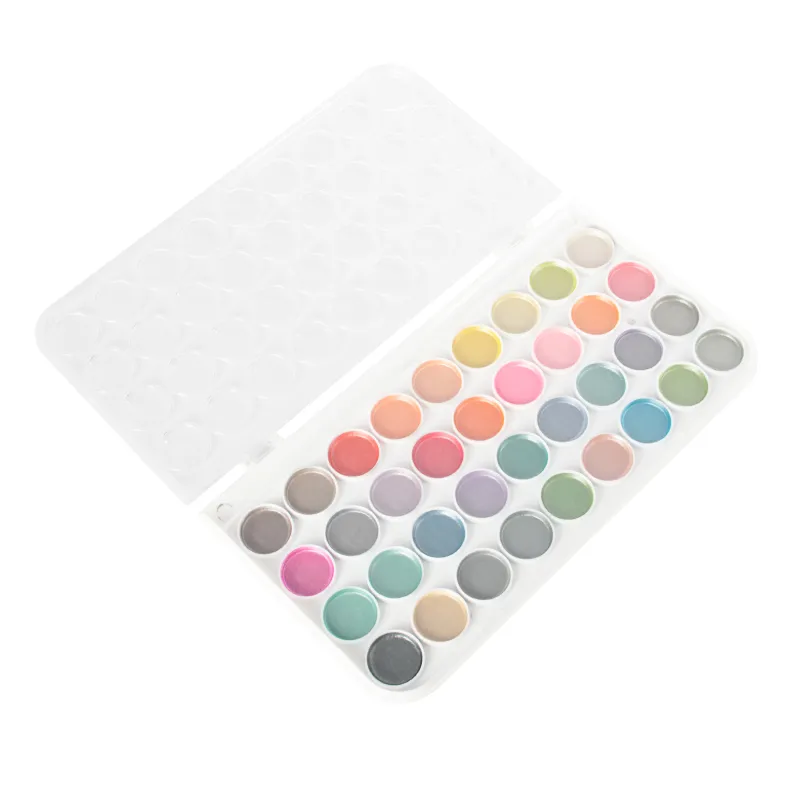- English
- Español
- Português
- русский
- Français
- 日本語
- Deutsch
- tiếng Việt
- Italiano
- Nederlands
- ภาษาไทย
- Polski
- 한국어
- Svenska
- magyar
- Malay
- বাংলা ভাষার
- Dansk
- Suomi
- हिन्दी
- Pilipino
- Türkçe
- Gaeilge
- العربية
- Indonesia
- Norsk
- تمل
- český
- ελληνικά
- український
- Javanese
- فارسی
- தமிழ்
- తెలుగు
- नेपाली
- Burmese
- български
- ລາວ
- Latine
- Қазақша
- Euskal
- Azərbaycan
- Slovenský jazyk
- Македонски
- Lietuvos
- Eesti Keel
- Română
- Slovenski
- मराठी
- Srpski језик
How Do You Store Solid Watercolor Paints?
Watercolor painting is a captivating medium known for its fluidity and translucency. Whether you’re a beginner or an experienced artist, proper storage of your watercolor paints is essential to maintain their quality and ensure a smooth painting experience. Solid watercolor paints, typically available in pans or tubes, need a bit of care to stay fresh and usable over time. This blog will guide you through the best practices to store your solid watercolor paints, ensuring they remain vibrant and ready for your next creative session.
Why Proper Storage Matters
Proper storage of solid watercolor paints is important for several reasons:
- Preservation of Color Quality: Storing paints correctly ensures the pigments retain their original brightness and intensity.
- Prevention of Mold or Mildew: High humidity can cause paints to develop mold, which can ruin them.
- Ease of Use: Well-maintained paints are easier to reactivate with water, making painting sessions smoother and more enjoyable.
Let’s explore how to store solid watercolor paints in pans, palettes, and tubes effectively.
1. Storing Watercolor Paints in Pans and Palettes
Most artists prefer using solid watercolor paints in pans or palettes because of their portability and convenience. However, proper storage is crucial to prevent them from drying out excessively or becoming contaminated.
- Keep the Palette Clean: After each painting session, wipe away any excess paint or mixing residue with a damp cloth. This prevents unwanted color mixing and keeps the palette tidy for future use.
- Allow Paints to Dry Before Closing the Lid: Always let your paints dry out completely before closing your palette or pan set. This prevents the development of mold or mildew, which thrives in damp environments.
- Use a Secure Lid or Case: If you’re storing paints in pans, ensure that the lid is secure to prevent dust and debris from settling on the surface. Some palettes come with airtight seals to keep moisture out and protect the paints.
- Avoid Direct Sunlight and Extreme Temperatures: Store your palette in a cool, dry place away from direct sunlight, which can cause the paints to crack or fade over time. Avoid storing paints in environments with fluctuating temperatures, as this can cause the paints to become brittle.
- Organize with Color Order: Arrange your colors in a logical order, such as by hue or value. This not only helps you find colors quickly but also prevents confusion and contamination during painting.

2. Storing Watercolor Paints in Tubes
While tube watercolors are more common for liquid application, they can also be used to fill empty pans. Proper storage of watercolor tubes prevents them from drying out or leaking.
- Cap the Tubes Tightly: After each use, ensure the caps are securely tightened to prevent air from entering the tubes. If the cap gets stuck, use a damp cloth to gently twist it off rather than applying too much force, which can damage the tube.
- Store Tubes Upright: If possible, store tubes upright with the caps facing up. This reduces the risk of leakage and prevents the paints from settling at the cap, making them easier to squeeze out next time.
- Use a Storage Box: Place tubes in a dedicated storage box with dividers, so they don’t roll around or get damaged. This is especially useful if you have a large collection of different colors.
- Label the Tubes: Over time, the labels on watercolor tubes can wear off. Consider labeling the tubes with a permanent marker to ensure you can identify the colors even if the original label fades.
3. Long-Term Storage Tips for Watercolor Paints
If you’re storing solid watercolor paints for an extended period, consider these additional tips:
- Keep the Humidity Low: High humidity levels can encourage mold growth in watercolors. Store your paints in a room with controlled humidity levels, or consider using a dehumidifier.
- Use Silica Gel Packs: Place silica gel packs in your storage container to absorb excess moisture and keep the paints dry.
- Inspect Regularly for Mold or Deterioration: Every few months, check your paints for any signs of mold, mildew, or drying. If you notice any unusual spots or growths, clean the affected area and let the paints dry completely before reusing them.
- Use Airtight Containers: For long-term storage, consider placing your pans or palettes in airtight containers to minimize exposure to air and moisture.
4. Rehydrating Dried Watercolor Paints
If your solid watercolor paints have dried out, don’t worry! They are still usable. Watercolors are designed to be reactivated with water, even if they have completely dried. Simply:
- Add a few drops of clean water to the dried paint and let it sit for a few minutes.
- Gently mix the paint with a brush to create a smooth consistency.
- Repeat the process if necessary until the desired consistency is achieved.
Avoid using too much water, as this can cause the paint to become too diluted, affecting the color’s vibrancy.
Conclusion
Proper storage of solid watercolor paints is essential for preserving their quality and extending their usability. By taking a few extra steps to clean, dry, and organize your paints, you’ll ensure they stay vibrant and ready for use whenever inspiration strikes. Whether you’re storing pans, palettes, or tubes, these tips will help you maintain your watercolor paints in pristine condition for years to come.🎨
High quality Solid Watercolor with cheap price can be wholesaled from our factory called Changxiang Stationery which is one of the manufacturers and suppliers in China. If you are interested, please contact andy@nbsicai.com.




